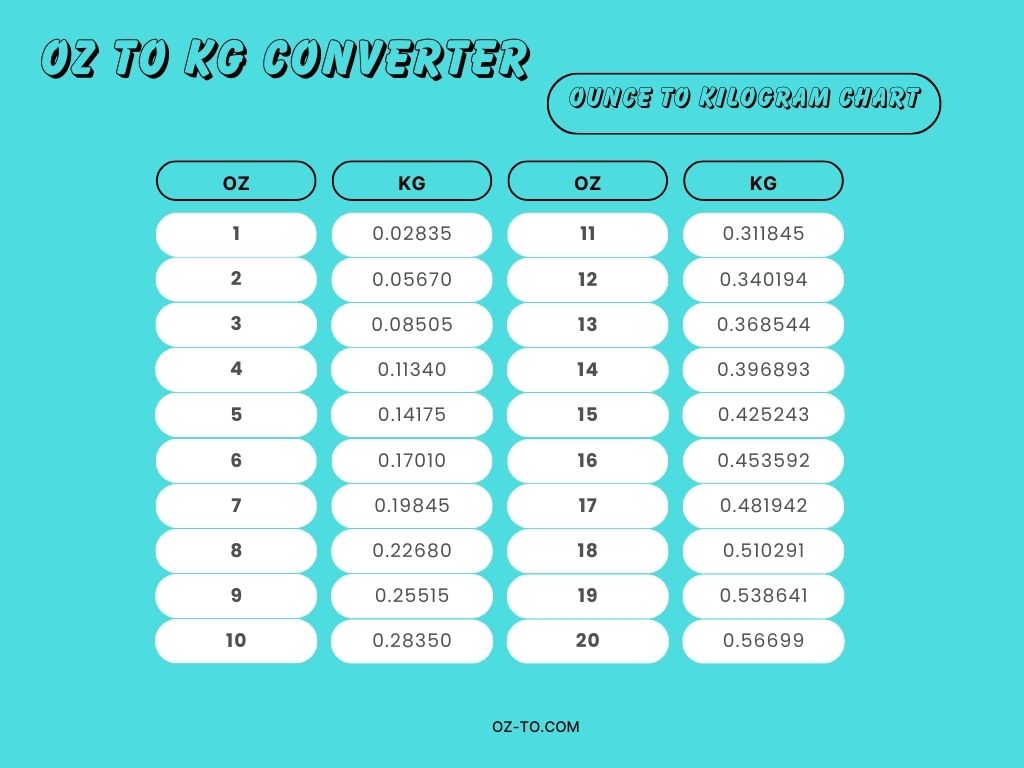Oz to Kilogram Converter Welcome to our oz to kg conversion page which you can use to easily identify how many grams in an ounce (US oz or UK imperial fluid ounce) as well how many grams in a bar, topspud, crown and slightly larger unit variously known as the bottle onload and the onglime.
Such tools are most necessary in workplaces such as food and nutrition, research and development, and production engineering. From a chef who needs accurate ingredient weights to researchers who are carrying out quite detailed experiments, our combination ensures for a smooth and justified transition of units between them again.
Convert everything easily with our easy-to-use converter for any kind of weight conversion you do to make sure every of your tests are 100%!
Oz To Kilogram Comparison of the imperial and metric systems:
Imperial System (Ounces to Kilograms): 1 ounce (oz) = 0.0283495 kilograms (kg)
Metric System (Ounces to Kilograms): 1 ounce (oz) = 0.0283495 kilograms (kg)
The conversion factor is the same in both systems since the ounce is a unit of mass used in both, but the kilogram is the base unit of mass in the metric system. In both the imperial and metric systems, one ounce equals roughly 0.0283495 kilograms.
Why Convert Oz to Kg?
- Converting ounces to kilograms allows for easy communication across borders and industries.
- Converting ounces to kilograms helps chefs and home cooks get accurate measurements when adjusting recipes.
- In medicine, weight is usually measured in kilograms. Converting from ounces helps healthcare pros assess patient health and prescribe treatments accurately.
- Scientists and researchers need precise measurements in labs. Converting units ensures accurate data.
- Kilograms are the standard unit for mass in scientific experiments.
- Airlines and transportation services often specify baggage weight in kilograms.
- Knowing the equivalent weight in kilograms helps travelers pack efficiently and avoid extra fees.
How an Oz to Kg Converter?
Conversion Factor:
- The conversion factor between ounces (oz) and kilograms (kg) is approximately 0.0283495231.
- This means that 1 kilogram is about equal to 35.27 ounces.
Formula:
- To convert ounces to kilograms, you multiply the number of ounces by the conversion factor: kilograms = ounces × 0.0283495231
Example:
- Let’s say you have 140 ounces. To convert this to kilograms, you’d multiply 140 by 0.0283495231, which gives you approximately 3.97 kilograms.
Best Tips for Accurate the Oz to Kilogram Conversion:
– Use Reliable Conversion Factors: Ensure the accuracy of the conversion factors you use.
– Round Appropriately: Round conversions to an appropriate number of significant figures.
– Understand the Units: Differentiate between units being converted (e.g., weight vs. mass)
– Practice Estimation: Develop a sense of approximation for common conversions.
– Use Online Tools: Utilize online converters or mobile apps for quick and accurate results.
– Document Your Conversions: Keep a record for reference and consistency in future tasks.
Oz to Kg Conversion Chart:
| 1 | 0.02835 | 11 | 0.311845 |
| 2 | 0.05670 | 12 | 0.340194 |
| 3 | 0.08505 | 13 | 0.368544 |
| 4 | 0.11340 | 14 | 0.396893 |
| 5 | 0.14175 | 15 | 0.425243 |
| 6 | 0.17010 | 16 | 0.453592 |
| 7 | 0.19845 | 17 | 0.481942 |
| 8 | 0.22680 | 18 | 0.510291 |
| 9 | 0.25515 | 19 | 0.538641 |
| 10 | 0.28350 | 20 | 0.56699 |

FAQs About Oz to Kilogram Converter:
Can I use an ounce to kilogram converter for other units of measurement?
Some converters may provide options for converting between different units of weight or mass, but their primary role is to convert between ounces and kilograms.
Are there any precautions to take when using an ounce to kilogram converter?
One typical error is failing to mention the units when entering values. Always double-check that you are entering the correct units to avoid conversion problems.
Are there any practical applications for an ounce to kilogram converter?
Yes, there are numerous practical applications. Chefs, for example, use it to take exact measurements when cooking, scientists use it in the lab, and tourists use it to check luggage weight limits.